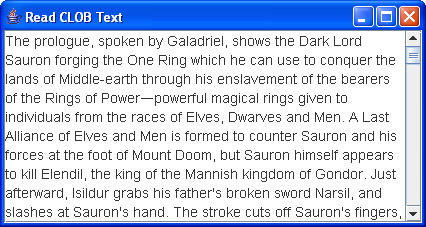Archive for the ‘Oracle’ Category
A Quest Addendum … to OpenWorld from SFO
 I forgot to post the note from Alan Shook, a friend from my days in Oracle Support and teaching at Regis University. Alan works for Quest software, and he works with the Stat for E-Business Suite product. He’s passionate about the product, as you can see in his note. Alan has contributed two appendices on leveraging Quest’s tools to a book that Scott Mikolaitis and I are writing about the Oracle eBusiness Suite. Beyond the upgrade, tools are critical to cutting costs when you convert data.
I forgot to post the note from Alan Shook, a friend from my days in Oracle Support and teaching at Regis University. Alan works for Quest software, and he works with the Stat for E-Business Suite product. He’s passionate about the product, as you can see in his note. Alan has contributed two appendices on leveraging Quest’s tools to a book that Scott Mikolaitis and I are writing about the Oracle eBusiness Suite. Beyond the upgrade, tools are critical to cutting costs when you convert data.
Alan sums it up by …
“Stat is an Application Change Management product from Quest Software that supports the entire change lifecycle of the Oracle E-Business Suite. It is a single-integrated solution for issue tracking, process control and workflow, version control, migrations, recovery, patch management, auditing, and reporting. Stat provides native support for Oracle flat files, Developer objects, AOL object types, and a variety of application setups. Stat leverages its change management architecture to automate the manual steps required in patching and migrations while simultaneously helping you resolve process control, auditing, reporting and security concerns. The product has a security model to prevent unauthorized changes from being migrated through restricting access to do such task and limiting the rights to do so to those individuals you identify responsible for such actions. The change management process can be enforced with Stat’s workflow engine, incorporating approval requirements while providing full audit trail. Stat conducts all activities in an Oracle-supported manner, hence why it is validated by Oracle for R12 and for Oracle On-demand environments.”
Static IP steps added to Mac configuration of VMWare
I’ve added the Windows static IP networking steps to the How to configure Mac OS X as an Oracle Client. I’ll try to get back and update the entry for a couple Linux distros (distributions) next week.
If you get the DNS configuration wrong but everything else right, you’ll be able to connect to Oracle. Unfortunately, you won’t be able to make a call out of the VM with the browser.
Oracle OpenWorld 2008 – Day 3
Key Note and News:
There were two big announcements today. The one that I liked the most was what Andy Mendelsohn said, that there will be an Oracle Database 11g Express Edition. You can read the full report in the NY Times. You’ll also find that no date for 11gR2 is available but the beta code must be very close since they’re seeking beta testers.
 The second announcement was the big “X” secret alluded to for Larry Ellison’s key note. Larry basically announced the HP Oracle Exadata Storage Server and HP Oracle Database Machine. There seems to be some cynicism about it, but it sounds interesting.
The second announcement was the big “X” secret alluded to for Larry Ellison’s key note. Larry basically announced the HP Oracle Exadata Storage Server and HP Oracle Database Machine. There seems to be some cynicism about it, but it sounds interesting.
The general idea is to tightly couple hardware and software platforms. Integration of the two components simplifies delivery by reducing complexity, and increases performance for high throughput uses of the Oracle Database. It really makes sense.
For example, if you look at Steve Jobs’ success at Apple (this time around) that’s exactly what he did. He simplified the number of offerings, focused on the quality of hardware and software, and limited the risk of hardware and software incompatibility. Apple seems to clearly dominate the highend market, or at least it made an awesome showing at Oracle OpenWorld 2008 (by my anecdotal eyeballing of machines).
The last point is very close to what Larry’s proposing. By focusing efforts on high load OLTP and data warehouse installations with a one-two punch of integrated hardware and software, Oracle can become more scalable without creating different database engines. More or less, Oracle achieves higher throughput by leveraging hardware with the same product. This means he leverages a great product across new markets (probably IBM’s existing markets), without increasing the number of offerings. He one-ups Steve Jobs because he makes the hardware HP’s problem. Deming (that quality engineering guy) might say Larry risks success by ceding hardware components to a supplier. I don’t think the risk is any greater than the risk Apple has in ceding component manufacturing. The question is: Can HP manage the process as well as Apple now that Carly Fiorina is gone?
Humorous or prophetic, does this shift in platform have a hidden benefit as great as changing from the PowerPC to Intel processor. I don’t see it but this may be a beginning … What I can see immediately, is that configuring a RAC environment may become much easier if everything is prebundled.
Virtualization:
 As you know from my blog posts, I really like virtualization software. So, … it’s probably not a surprise that I spent some time talking virtual machines with my favorite vendor – VMWare.
As you know from my blog posts, I really like virtualization software. So, … it’s probably not a surprise that I spent some time talking virtual machines with my favorite vendor – VMWare.
While hanging there and collecting more information on options, I met Dave Welch. Dave is a consumate maven of virtualization with Oracle and Oracle eBusiness Suite deployments. He had some awesome performance statistics that I’m still digesting. Basically, he debunked a lot of rubish that’s out there about overhead. He works for House of Brick Technologies out of Omaha, Nebraska. Dave actually demonstrated VMWare Stage Manager and VMWare Lab Manager, and told us about the bundling of these two into a suite. They appear a great soltuion to managing and deploying virtual machines. If you’re wondering were the VMWare folks were, don’t worry they were busy somewhere else.
Probably the coolest feature that I saw was how you could clone an Oracle eBusiness Suite for testing and move it to a virtual subnet without cloning. You can do this because the virtual subnet preserves the hostname, IP, et cetera. However, it’s not a cheap date but they’ve a reduced price for next few months. Isn’t that marketing the rule for products at Oracle OpenWorld?
While I like and use VMWare, Sun Microsystems VirtualBox appears very interesting. It also supports the Mac, which makes it a high priority in my testing queue. I’ll let you know what I find. The RedHat entrant in virtualization is Solid ICE. Another item for my list, oh gosh … it keeps on growing.
Business Judgment:
I have to give a business acumen prize to Wells Fargo Bank. Having spent the first 10 years of my career at First Interstate Bank working on the evolution of banking systems, I learned the key rule about technology. Technology has to pay for itself by increasing revenue or decreasing costs.
 Wells Fargo Bank focused on an API that lets commercial accounts leverage banking services without human intervention. Their focus is to put the technology out there and leave their customers with the implementation costs, customization, and business process engineering. A sharp decision from my perspective but they could have gone one step further. They should have considered placing it in the open source community. The software ultimately has a very short competitive edge, and the return on initial investment would have been higher if they’d capitalized on the creativity of the open source community.
Wells Fargo Bank focused on an API that lets commercial accounts leverage banking services without human intervention. Their focus is to put the technology out there and leave their customers with the implementation costs, customization, and business process engineering. A sharp decision from my perspective but they could have gone one step further. They should have considered placing it in the open source community. The software ultimately has a very short competitive edge, and the return on initial investment would have been higher if they’d capitalized on the creativity of the open source community.
The prize for continuing product evolution through the open source community probably goes to SugarCRM. They place components into their product versions and then into their version of sourceforge (www.sugarforge.org). There, the community can examine, innovate, and improve the software.
Open Source:
 I had a chance to catch up with Chris Jones on PHP and open source scripting. Chris and Alice Holloway provide that wonderful book on PHP known as the Underground PHP and Oracle Manual. It’s great to catch up on Oracle’s commitment to Open source. Remember my favorite news of the day – Oracle Database 11g Express Edition is coming. That’s evidence that Oracle sees the open source community as important and PHP and scripting languages as valuable.
I had a chance to catch up with Chris Jones on PHP and open source scripting. Chris and Alice Holloway provide that wonderful book on PHP known as the Underground PHP and Oracle Manual. It’s great to catch up on Oracle’s commitment to Open source. Remember my favorite news of the day – Oracle Database 11g Express Edition is coming. That’s evidence that Oracle sees the open source community as important and PHP and scripting languages as valuable.
In summary, I’d like to thank TUSC for their courtesy in broadcasting Larry’s key note from their demonstration area. They’re truly a class act! Tomorrow, it’s time to go home. Naturally, I gave the party ticket away to somebody who would enjoy it. The last official day of Oracle OpenWorld 2008 must be left to another to report on … 
Oracle OpenWorld 2008 – Day 2
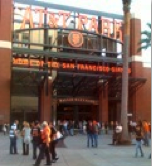 Day 2 is a wrap. As we left AT&T Park, the Giants’ were behind by one run. It was a hard call who I wanted to win because we lived in Colorado for 7 years cheering for the Rockies. It was a wonderful ball park, and the first time I’ve made it to a Giants game since they played at Candlestick Park.
Day 2 is a wrap. As we left AT&T Park, the Giants’ were behind by one run. It was a hard call who I wanted to win because we lived in Colorado for 7 years cheering for the Rockies. It was a wonderful ball park, and the first time I’ve made it to a Giants game since they played at Candlestick Park.
The publisher’s seminar was very informative about direction and product. The summary may surpise some, but ultimately they seem to make good sense. Of course the big one is withheld until Larry delivers his keynote. I’ll report it as soon as I hear it.
The following summarizes what I heard:
Cloud Computing
Cloud computing is definitely on the menu for Oracle. Oracle has an FAQ for Cloud computing here. An exisitng API supports it. You can use Enterprise Manager to backup to Amazon EC2, but first you must run the Cloud Backup Installer. It uses the EM tape backup, which extends a previous API that existed for tape drives.
APEX
APEX is popular (oh, yes that’s true). Rumor has it that there are 250,000 developers using the product. APEX is also in the same space as Oracle Forms, and APEX will provide an Oracle Forms’ conversion tool to an improved Web 2.0 solutions.
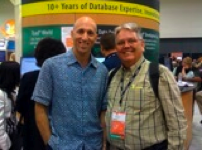 SQL*Developer
SQL*Developer
Oracle statistics indicate there have been 1.5 million downloads of SQL Developer. While Quest seemed to feel that Toad licenses haven’t declined. Quest also mentioned that they might consider porting Toad to the Mac OS, but that’s a second subjunctive that’s technically a hypothetical remark.
The announcement today on SQL Developer was that it will soon include a data modeling tool. The up or downside on that announcement is that the ERD’s look like the return of Oracle*Method (why not? ;-)). Running down the other perspective on SQL*Developer let me connect with Steven Feuerstein again this year. By the way, he’s got a new PL/SQL book that’ll be released some time late next year.
Oracle 11g Upgrade Oppotunity
The discussion today covered that the cost of upgrading from Oracle 9iR2 to 11gR1 is less than an upgrade from Oracle 9iR2 to 10gR2. The reason for the change are those long overdue improvements in how upgrades work in Oracle 11g. Though there was mention that the first major patch of Oracle 11g is due shortly after OpenWorld 2008 (yes, that means October or …. maybe November). Oracle also mentioned that 5% of customers have upgraded to 11gR1 without the major patch. Oracle expects another 10% of customers to upgrade to 11gR1 after the patch release. A significant feature of the upgrade process is the automatic migration of all execution plans. I have to also champion the utility of the new Automated Database Diagnostic Manager (ADDM) in the Oracle Database 11g because it is sweet!
Java Developers working with Oracle
The numbers thrown out were 100,000 developers in 2005 and approximately 1,000,000 today. It seems Java inside the Oracle database and integrated through the JDBC with Oracle has always finally found its place in the mainstream Oracle community.
That’s about all the key points from the publisher seminar.
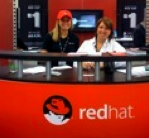 Visiting vendors is always important. RedHat is a big stop each year. This year was a pleasant surprise because they’ve got a new centrally managed identity, policy, and audit information product (IPA) for Linux and Unix environments. It uses open technologies and standards, including LDAP and Kerberos. They also have an open source virtualization software – Solid ICE.
Visiting vendors is always important. RedHat is a big stop each year. This year was a pleasant surprise because they’ve got a new centrally managed identity, policy, and audit information product (IPA) for Linux and Unix environments. It uses open technologies and standards, including LDAP and Kerberos. They also have an open source virtualization software – Solid ICE.
Jim Brennan, Senior Product Manager, gave us a great demonstration of the Red Hat Enterprise IPA tool. It was impressive in how simply it works and I could easily see how I could leverage it to manage the student accounts on the servers I administer.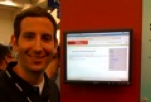
That’s it for Day 2 … the other tidbits will have to fade away. I apologize for it being late but it took a while to make it back to the hotel.
Oracle OpenWorld 2008 – Day 1
I just finished my book signing. Alas, no body showed up. Rumor has it books sales are down yet again this year. I guess that’s because folks search the web.
 I think one of the mystery photographers caught me sitting at the table while I was waiting for the throngs of folks to buy my latest PL/SQL book (obviously in some dream state). Since I’ve heard Oracle Database 11g adoption rates are low, at least from a few vendors here at OpenWorld, perhaps I can blame that.
I think one of the mystery photographers caught me sitting at the table while I was waiting for the throngs of folks to buy my latest PL/SQL book (obviously in some dream state). Since I’ve heard Oracle Database 11g adoption rates are low, at least from a few vendors here at OpenWorld, perhaps I can blame that.
Things are much the same as they were last year, the year before, et cetera. However, the real business of the conference occurs in the Game Room of Moscone West. As you can see the budget dollars of organizations are well spent here.
 Hopefully, there aren’t too many managers who visit my blog. These pictures probably shouldn’t be seen by management. Especially, if they’re the ones approving the expense reports, eh? I hope that nobody gets busted from these photos. 🙂
Hopefully, there aren’t too many managers who visit my blog. These pictures probably shouldn’t be seen by management. Especially, if they’re the ones approving the expense reports, eh? I hope that nobody gets busted from these photos. 🙂
After the soda and snack here in the OTN lounge, I’m Off to a 5:30 p.m. session. Then, I’m heading over to the OTN Night at the Hilton in San Francisco. It starts at 7:30 p.m. this evening. We’ll only stay about 30 minutes or so to visit and then off to check in at the hotel.
Also, thought some of those taking classes at night or in college would be interested to know about the iPhone Developer University Program. It’s new and slick. We’ve actually got a course up and running this term at BYU – Idaho. A couple students are already working for a company developing iPhone applications remotely. I think that they’re calling it insourcing to Idaho.
 A Google search that showed up in my statistics wanted to know how to check for external table file sources. I’ve got a sample that should be posted later this evening. If there are things you’re interested in that I’ve not explored, let me know. I always like new ideas but time typically goes to the projects at hand.
A Google search that showed up in my statistics wanted to know how to check for external table file sources. I’ve got a sample that should be posted later this evening. If there are things you’re interested in that I’ve not explored, let me know. I always like new ideas but time typically goes to the projects at hand.
The reason for the Mac OS X configuration material is because I’ve been building a server to run multiple instances of the Oracle Applications 11i eBusiness Suite for the book I’m currently working on. Along with that, I’ve been documenting configurations for OPAL (Oracle, PHP/Perl/Python, Apache, Linux) stacks on various platforms. I’ll post my own version of Ubuntu later this week or on the weekend. Unfortunately, I’ve got some real work developing activity diagrams, and they’ll compel my attention this week between sessions and at the hotel.
More on Configuring the Mac OS for Oracle 10g Client
I’ve been revising and correcting typos plus adding new content to that Configuring Mac OS for the Oracle 10g Client blog page. It’s more complete now. It also shows you how to connect from one virtual machine to another by using host file resolution.
Also, I’ve decided that the network configuration steps for VMWare NAT belong in a separate blog page. I’ll try to get that out after Oracle OpenWorld 2008. For those you can’t wait, you’ll find the networking files here:
Mac OS X:
/Library/Application Support/VMWare Fusion/vmnet8 |
Linux:
/etc/vmware/vmnet8 |
Windows:
C:\WINDOWS\System32 |
You’ll find three files. The dhcpd.conf file configures DHCP. The nat.conf file configures incoming ports to your virtual machines, which is known as port forwarding. The mac.conf file stores the physical layer MAC address for your machine.
Oracle OpenWorld 2008
Oracle OpenWorld 2008 is next week! How time flies since last year and the year before … Actually, I never attended OpenWorld in the almost 9 years I worked at Oracle. Oddly, I’ve attended each year since leaving.
For virtual acquaintances out there in the cybervoid (courtesy of Neuromancer by Gibson), perhaps we’ll meet at Oracle OpenWorld 2008. If you want to run me down, McGraw-Hill has scheduled me for a book signing Monday afternoon at 2:00 to 2:30 p.m. in the Barnes and Noble store. It is on the second floor of Moscone West. If not, we may pass in the halls, but I’ve posted a photo in my @About page for you if you’re interested in saying hi.
You may also catch up with me at the San Francisco Giant’s game on Tuesday evening. It’s probably a character flaw, but I’m a Giant’s fan for life. I’m still hoping for another World Series appearance in my lifetime.
If you’re there, agitate to dump DUAL! That is, request that Oracle consider making it optional, like MySQL. It’s so embarassing to say MySQL got it right and excuse Oracle for not making the behavior implicit.
Anyway, I look forward to meeting you if you’re there. If you’re not, I’ll post photos like so many others …
Update on how to configure Oracle Client for the Mac OS
The best laid plans of mice and men go awry too easily. I wrote the article on configuring the Oracle Client because it was tiresome to hear how hard it was when it wasn’t. Then, my students tried the bridged networking instructions, which failed on our campus.
Why did they fail? They failed because our wireless network is configured to disallow students to call out to another machine. You might guess that’s to eliminate gaming across the wireless network. This also has the effect of disabling a call to a virtual machine running under a bridged network.
I’ve updated the original post to include instructions for configuring NAT to work. This should help those who work in environments where the router configuration poses access limitations.
A perspective on Oracle’s development architecture
When I wrote my first PHP book, I felt silly explaining the recursive acroynm because PHP could call HTML and HTML could call PHP. I also included the discussion (misnomer or not) on Paul’s Home Page (PHP).
It struck me when I wrote it that Oracle SQL*Plus environment set the pattern for recursvie call environments. It provided the ability to interactively work with the database or call the database through another program unit (whether internal or external).
You’ll find a diagram that hopefully helps you visualize how Oracle implements SQL*Plus, SQL, PL/SQL, and external libraries in this post.
Reading a CLOB through the JDBC
I was working through some questions on the Oracle Technical forum, and thought it might be helpful to post a quick example for reading a CLOB from the database. It’ll produce the following Java Swing application view:
